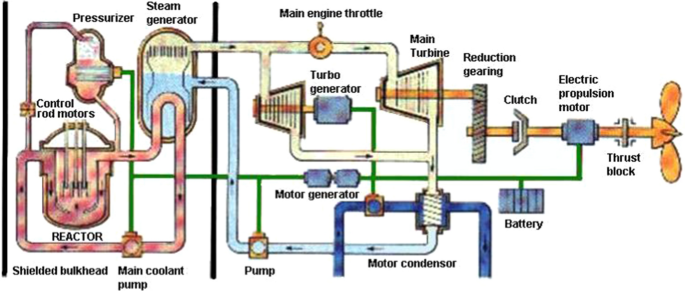The shipping industry is at a critical stage in the present times, driven by the need to balance economic growth and efficiency with environmental responsibility. While the shipping sector contributes heavily to the global economy, it contributes significantly to global greenhouse gas emissions, accounting to 3% of annual CO2 emissions. To address these challenges, shipping companies are increasingly turning to advanced technologies like Smart Propulsion Systems for sustainable shipping. These systems are designed to optimize fuel consumption, enhance energy efficiency, and help achieve the International Maritime Organization’s (IMO) ambitious decarbonization goals. This blog will explore what smart propulsion systems are, how they benefit the shipping industry, and their role in creating a sustainable future for maritime trade.
What is Smart Propulsion?

A propulsion system in ships is a setup that helps the ship move forward in the water. It works by converting energy from an engine (like diesel or gas engines) into motion, typically by spinning a propeller. The propeller pushes water backward, which in turn moves the ship forward. Most modern ships use engines to power these systems, though some older or specialized ships may use sails or steam turbines.
A smart propulsion system takes this a step further by using advanced technology like artificial intelligence (AI) and real-time data analysis to make the propulsion more efficient. It monitors things like speed, engine performance, and sea conditions, then automatically adjusts the system to save fuel and reduce emissions. This makes the ship’s operation smoother, more energy-efficient, and environmentally friendly.
In simple terms, a smart propulsion system is like a regular ship engine, but it’s much smarter, adjusting itself constantly to save energy and keep the ship running smoothly. The system integrates the ship’s control mechanisms with sensors and algorithms, which provide real-time feedback to optimize operations. This ensures the ship runs at peak energy efficiency in all conditions. For example, smart propulsion fine-tunes parameters such as propeller pitch, engine power, and ship speed in real-time, ensuring optimal performance. Moreover, the system provides predictive maintenance capabilities by identifying potential wear and tear in engines and components before they grow into costly repairs or cause unplanned downtime.
How Does Smart Propulsion Help Shipping?
The maritime industry faces several challenges, such as rising fuel costs, strict environmental regulations, and the constant demand for operational efficiency. Smart Propulsion Systems address these challenges in several key areas:

1. Fuel Efficiency: Smart Propulsion continuously analyzes real-time data and makes necessary adjustments, such as tweaking engine power or altering propeller pitch, to minimize both fuel and energy consumption. These dynamic adjustments improve energy efficiency, resulting in energy savings for shipping companies, as fuel is one of their most significant operational costs.
2. Regulatory Compliance: The IMO has set a target for a 30% reduction in greenhouse gas emissions by 2030, and an ambitious 80% reduction by 2040. Smart Propulsion helps operators meet the Carbon Intensity Indicator (CII) targets, ensuring that their ships remain compliant with evolving regulations without sacrificing operational performance.
3. Operational Adaptability: Ships encounter ever-changing conditions, from calm seas to rough waters. Smart Propulsion helps make sure that the ship operates at peak energy efficiency regardless of these changes, adapting operations dynamically to the real-time environment. This increases the vessel’s energy-efficient performance, providing resilience and reducing the need for manual intervention.
4. Predictive Maintenance: Smart Propulsion’s ability to monitor real-time data allows it to predict when maintenance is required, helping shipowners avoid costly downtime. This active approach also improves the safety and energy efficiency of the vessel, extending its lifespan.
The Benefits of Smart Propulsion Systems
Smart Propulsion Systems lead to benefits other than fuel savings. They contribute to environmental sustainability improving energy efficiency and operational flexibility. Some of the key benefits include:
1. Significant Cost Savings: Smart Propulsion can lead to fuel savings of up to 15%, depending on the vessel and its operational conditions. These potential energy savings can accumulate over time, particularly for companies with large fleets, making smart propulsion a financially attractive investment.
2. Environmental Responsibility: Reducing fuel consumption naturally lowers carbon emissions, which is crucial in the fight against climate change. Smart Propulsion Systems align with the IMO’s strategy to reduce greenhouse gas emissions, helping ships meet their decarbonization goals, including achieving net zero emissions by 2050. Lower carbon dioxide emissions benefit both the environment and a company’s regulatory compliance.
3. Extended Engine Lifespan: By optimizing how the vessel operates, smart propulsion reduces the wear and tear on engines and other mechanical systems. This results in less energy, fewer breakdowns, lower energy costs, and longer-lasting equipment. It also reduces the overall operating and maintenance costs, further enhancing operational energy efficiency.
4. Simplicity and Flexibility: Smart Propulsion Systems are highly adaptable, allowing them to be applied into a wide variety of ships, both newly built and older vessels. These systems do not require a lot of rebuilding making them an good option for ship operators looking to modernize their fleet without increasing expenses at a high rate.
Smart Propulsion and Sustainable Maritime Trade
The global shipping industry is under growing pressure to reduce its impact on the environment. Groups like the International Maritime Organization (IMO) are pushing for stricter rules on pollution and emissions to encourage sustainable trade on the seas. One of the most effective tools helping the shipping industry reach these goals is Smart Propulsion Systems.
1. Carbon Levy and Incentives
As part of efforts to reduce pollution, a carbon tax has been suggested. This would make ships that release too much carbon dioxide pay a fee, pushing them to use cleaner technologies like Smart Propulsion, which helps lower fuel use and pollution. The fee could be between $150 and $300 for every ton of greenhouse gases released. The money collected from these fees could be reinvested into clean technologies, helping the industry move toward renewable energy faster.
2. Green Technologies and Smart Propulsion
Many ships are starting to use green technologies like sails or wind power to reduce their need for fuel. Smart Propulsion Systems can work well with these eco-friendly methods to further reduce the use of fossil fuels. For example, ships that use both Smart Propulsion and wind power can use weather forecasts to find strong winds at sea, saving fuel and lowering carbon emissions.
3. Meeting Environmental Goals
The IMO has set clear targets for reducing pollution. They want shipping to cut its emissions by 30% by 2030, 80% by 2040, and reach zero emissions by 2050. Smart Propulsion plays a key role in meeting these targets by using energy wisely, reducing pollution, and allowing ships to switch to alternative fuels like biofuels or hydrogen. This helps the shipping industry move toward a cleaner future.
Summary
Smart Propulsion Systems offer a smart and efficient solution to the problems the shipping industry is facing today. These systems help ships use less fuel, adapt to changing conditions, and follow new environmental rules. As regulations get stricter, Smart Propulsion will become even more important in reducing pollution and promoting cleaner, greener shipping. Companies like Nautilus Shipping are leading the way by adopting these technologies, making the future of shipping cleaner and more sustainable.
FAQs About Smart Propulsion Systems
1. What is Smart Propulsion in shipping?
Smart Propulsion uses advanced technology to help a ship run more efficiently. These systems adjust things like engine power automatically to save fuel and reduce pollution.
2. How do Smart Propulsion Systems help save fuel?
By tracking real-time data, Smart Propulsion Systems make constant adjustments to a ship’s operations. This can save up to 15% on fuel, depending on the ship and its conditions.
3. Are Smart Propulsion Systems expensive to install?
The cost of installing Smart Propulsion Systems can vary, but they often pay for themselves within six months due to fuel savings and lower maintenance costs.
4. How do Smart Propulsion Systems benefit the environment?
Smart Propulsion reduces a ship’s carbon footprint by making it more energy-efficient, which helps lower pollution. This aligns with global goals to reduce greenhouse gas emissions and supports the use of renewable energy.
5. How do Smart Propulsion Systems help meet global pollution goals?
Smart Propulsion helps ships meet the IMO’s targets by improving energy use and reducing greenhouse gases. They can also work with other green technologies, like wind power, to make shipping more eco-friendly.
By adopting Smart Propulsion Systems, the shipping industry can improve efficiency, cut pollution, and work toward a cleaner, more sustainable future.
